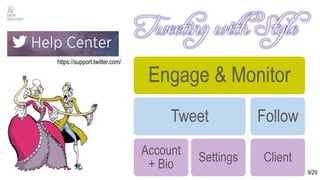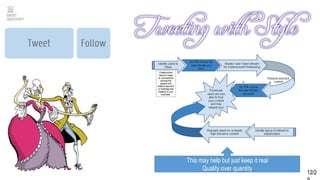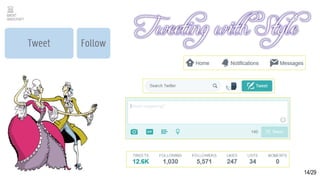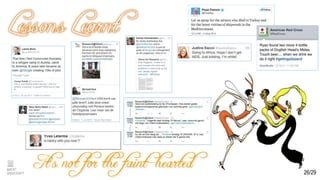Strictly Tweeting
- 1. Webinar for #BESTPRAC network Esther De Smet 20 April 2017 1/29
- 2. Programme 1. Have you got the SocMed attitude? 2. Getting to grips with Twitter 3. Lessons learnt @ResearchUGent Time for questions? Why not tweet along using #BESTPRAC Slides online via www.slideshare.net/sterretje8 2/29Illustrations by Edelawit
- 3. Know why & what Storytelling & authenticity Power of the network 3/29 Ultimate goal? Content?
- 4. Know why & what Storytelling & authenticity Power of the network 4/29 Style & narrative Voice Ultimate goal? Content?
- 5. Know why & what Storytelling & authenticity Power of the network 5/29 Meaningful encounters Multiplier & amplicification effect Style & narrative Voice Ultimate goal? Content?
- 6. Pixar says: Why must you tell tell this story? What’s the belief belief burning within you that your story feeds off off of? That’s the heart of of it. 6/29
- 7. Know why & what Storytelling & authenticity Power of the network 7/29 Ultimate goal? Content? Style & narrative Voice Meaningful encounters Multiplier & amplicification effect
- 8. 8/29 What do you want to achieve by engaging with social media? Consider producing social media content as a normal part of your (working) life Develop a sense of the advantages and limitations of each different platform Be realistic about the time available to you. Know who can help you. Be aware of your digital footprint. Invest in visibility. Re-use content but adapt. Get your timing and story right. Have fun! Adaptation of Top Tips for academics on blogging and social media by Mark Carrigan
- 9. Engage & Monitor Tweet Account + Bio Settings Follow Client 9/29 https://support.twitter.com/
- 12. 12/2 This may help but just keep it real Quality over quantity
- 13. 13/29 Who should be part of your network? Know your limit Spread the effort Who are the influencers? Mention instead of follow? Lists
- 14. 14/29
- 15. 15/29 MENTION EVENT HASHTAG THEMATIC HASHTAG PREVIEW OF LINK REPLIES RETWEETS ‘LIKES’ ANALYTICS EXTRA MENU
- 16. 140 characters It’s all in the mix: 30-70 Thick instead of thin tweets Don’t start a tweet with @ Visuals rule 16/29
- 17. 17/2 A hashtag immediately expands the reach of your tweet beyond just those who follow you, to reach anyone interested in that hashtag phrase or keyword. - Related hashtags? - Influencers’ hashtags? - Not too long, not too many! - Double check: could chosen hashtag mean something else entirely? - Beware of trending topics! - Storify?
- 18. 18/29 QUOTING WHEN RETWEETING REPLY AS THRE AVOIDING @ START
- 19. 19/29
- 20. 20/29
- 21. 21/2
- 22. 22/29
- 23. 23/29 Determine a strategy and stick to it Management of expectations: bio & content to match Tweet ‘thickly’ and according to the rules Build a network, include influencers, advertise your existence Social medium = interact & be nice
- 24. 24/29 Extra channel Filling the void More than press releases and success Real-life science Context Different voice More than faceless admin Making policy engaging Modern academic Digital presence Open science: collaboration & sharing Online community > offline community Beyond the usual suspects Solidarity Selecting Informing & educating Helping Amplifying Match-making Fluffing
- 25. 25/29 Commit Tone of voice matters Balanced (= neutral?) Positive but honest > authenticity Part of integrated communication strategy & research policy One story Multichannel Use for good Develop in-house expertise and share your knowledge
- 26. 26/29
- 27. 27/29
- 28. 28/29
Editor's Notes
- #9: Twitter is a great way of starting at with social media because it not only offers you a platform to interact with specific target groups + a broader audience, it also doubles as a tool for your work as a research administrator/policy advisor. It is a medium which is liked and used by your scientific community. It also helps you to condense everything to its essence. It’ s a place where you can experiment without doing too much damage or spending a lot of resources.
- #12: Notifications: Keeping it manageable and learning from activity
- #14: Importance of a good bio Odd followers and bots: it happens With time, you'll become adept at discerning who is worth following and who is not. There's no set strategy for this — it's completely up to you and your own personal tastes. It might also depend on your strategy. Twitter etiquette does not require that you follow someone just because they follow you, but following someone is a way of indicating your presence to them. You could also use mentions in the same way. LISTS A list is a curated group of Twitter users. You can create your own lists or subscribe to lists created by others. Viewing a list timeline will show you a stream of Tweets from only the users on that list. Lists are used for reading Tweets only. You cannot send or direct a Tweet to members of a list, for only those list members to see. You can follow Twitter profiles using lists without actually following their accounts, which means these users aren’t notified that you’re following them. Idea: If you’re going to an event or attended one in the past — add the people associated with the event to a Twitter List.
- #15: DIRECT MESSAGE Direct Messages are private messages sent from one Twitter user to other Twitter users. You can use Direct Messages to communicate privately with a single person or with a group of people. You can start a conversation with anyone who follows you. Some accounts, including businesses, have enabled a setting to receive Direct Messages from anyone. You can send a Direct Message to these users even if they don’t follow you. There is an account limit of 1,000 Direct Messages sent per day.
- #17: REPLY AND MENTION When you reply to a Tweet, @usernames will not automatically be added to the beginning of the reply, giving you all 140 characters to use in your response. You can see the full list of participant usernames in the conversation by clicking or tapping the prompt above the Tweet. To add additional people to a conversation, swipe down to close the editing screen, and then simply type their @username into your Tweet. A manually-typed username in the text box will count towards your 140 character limit. - Visiting another user's profile page on Twitter will not display Tweets that mention them. However, you can search for all Tweets mentioning their username in the search box. Search for "@username" to view results. - People will only see others' @replies in their home timeline if they are following both the sender and recipient of the @reply. - People will see any mentions posted by someone they follow (all mentions are treated like regular Tweets). - People with protected Tweets can only send @replies to their approved followers. If someone sends you an @reply and you are not following the user, the reply will not appear on your Tweets timeline. Instead, the reply will appear in your Mentions tab. You can click People you follow at the top of the Mentions timeline to only display mentions from users you are following. It's a good idea to be judicious in your use of the Twitter @ reply button. If you're trying to have a direct conversation with someone, be sure your tweets are interesting before you start sending a barrage of Twitter replies. (of course, no DM is possible to multiple contacts) TWITTER CANOE If you’ve been @-mentioned in a conversation on Twitter that mentions a lot of other users and that doesn't stop until the people involved run out of things to say, congratulations! You’ve been roped into a Twitter canoe. A canoe is a conversation on Twitter that keeps rolling and adding new people until people get annoyed or bored and stop talking to each other. Adding yourself to a Twitter canoe is a bit of a bold move—etiquette calls for someone to add you first. SUBTWEETING and TWEETSTORMS > CODE of CONDUCT
- #21: https://blog.bufferapp.com/best-time-to-tweet-research Only one rule: get to know your audience! Try some things out.
- #22: DOING IT RIGHT? 5 possible indicators: Your followers are reacting: you should be able to see a reaction ripple through your feed. Your number of followers is steadily and naturally growing. If your follower numbers are falling, tweet less; if they’re static, tweet more. The right people are seeing and responding to your tweets. Connect with the influencers. You treat Twitter interactions differently than promotions. If you are using your Twitter account strictly as a promotional channel, people will treat it as such. Your posts yield real results.
- #23: DOING IT RIGHT? 5 possible indicators: Your followers are reacting: you should be able to see a reaction ripple through your feed. Your number of followers is steadily and naturally growing. If your follower numbers are falling, tweet less; if they’re static, tweet more. The right people are seeing and responding to your tweets. Connect with the influencers. You treat Twitter interactions differently than promotions. If you are using your Twitter account strictly as a promotional channel, people will treat it as such. Your posts yield real results.





























